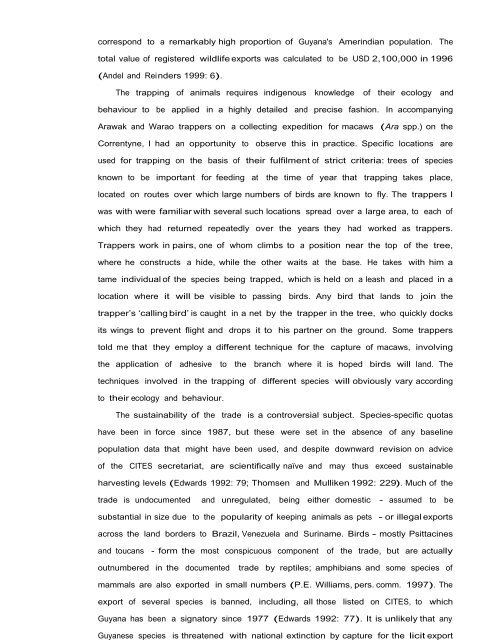Ethnoecology, Resource Use, Conservation And Development In A ...
Ethnoecology, Resource Use, Conservation And Development In A ...
Ethnoecology, Resource Use, Conservation And Development In A ...
You also want an ePaper? Increase the reach of your titles
YUMPU automatically turns print PDFs into web optimized ePapers that Google loves.
correspond to a remarkably high proportion of Guyana's Amerindian population. The<br />
total value of registered wildlife exports was calculated to be USD 2,100,000 in 1996<br />
(<strong>And</strong>el and Reinders 1999: 6).<br />
The trapping of animals requires indigenous knowledge of their ecology and<br />
behaviour to be applied in a highly detailed and precise fashion. <strong>In</strong> accompanying<br />
Arawak and Warao trappers on a collecting expedition for macaws (Ara spp.) on the<br />
Correntyne, I had an opportunity to observe this in practice. Specific locations are<br />
used for trapping on the basis of their fulfilment of strict criteria: trees of species<br />
known to be important for feeding at the time of year that trapping takes place,<br />
located on routes over which large numbers of birds are known to fly. The trappers I<br />
was with were familiar with several such locations spread over a large area, to each of<br />
which they had returned repeatedly over the years they had worked as trappers.<br />
Trappers work in pairs, one of whom climbs to a position near the top of the tree,<br />
where he constructs a hide, while the other waits at the base. He takes with him a<br />
tame individual of the species being trapped, which is held on a leash and placed in a<br />
location where it will be visible to passing birds. Any bird that lands to join the<br />
trapper’s ‘calling bird’ is caught in a net by the trapper in the tree, who quickly docks<br />
its wings to prevent flight and drops it to his partner on the ground. Some trappers<br />
told me that they employ a different technique for the capture of macaws, involving<br />
the application of adhesive to the branch where it is hoped birds will land. The<br />
techniques involved in the trapping of different species will obviously vary according<br />
to their ecology and behaviour.<br />
The sustainability of the trade is a controversial subject. Species-specific quotas<br />
have been in force since 1987, but these were set in the absence of any baseline<br />
population data that might have been used, and despite downward revision on advice<br />
of the CITES secretariat, are scientifically naïve and may thus exceed sustainable<br />
harvesting levels (Edwards 1992: 79; Thomsen and Mulliken 1992: 229). Much of the<br />
trade is undocumented and unregulated, being either domestic - assumed to be<br />
substantial in size due to the popularity of keeping animals as pets - or illegal exports<br />
across the land borders to Brazil, Venezuela and Suriname. Birds - mostly Psittacines<br />
and toucans - form the most conspicuous component of the trade, but are actually<br />
outnumbered in the documented trade by reptiles; amphibians and some species of<br />
mammals are also exported in small numbers (P.E. Williams, pers. comm. 1997). The<br />
export of several species is banned, including, all those listed on CITES, to which<br />
Guyana has been a signatory since 1977 (Edwards 1992: 77). It is unlikely that any<br />
Guyanese species is threatened with national extinction by capture for the licit export


